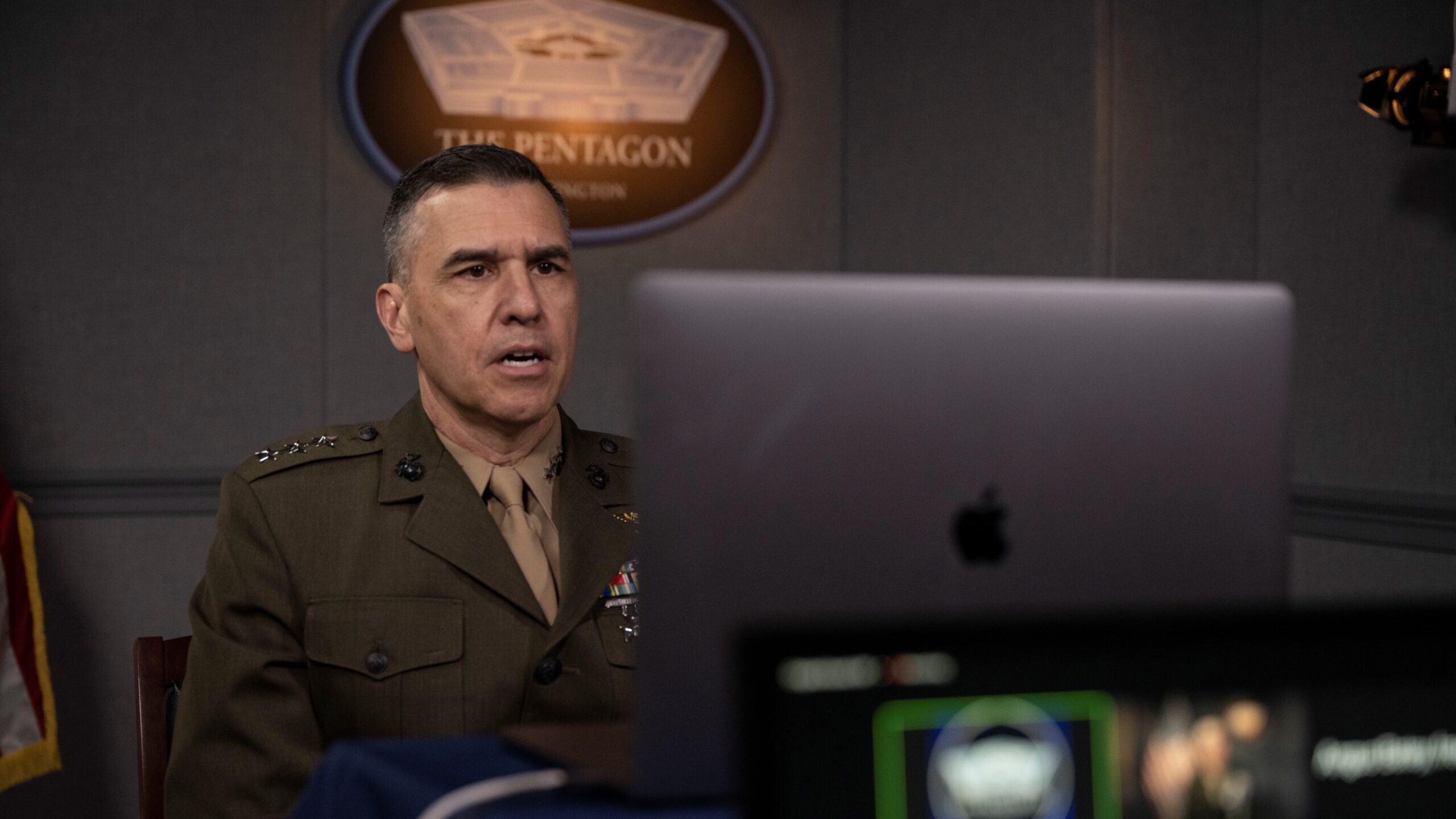
U.S. Marine Corps Lt. Gen. Dennis Crall, Joint Staff Chief Information Officer and Director for Command, Control, and Computer/Cyber, gives opening remarks to press members during a briefing on the Joint All-Domain Command and Control (JADC2) implementation plan, at the Pentagon. (DoD photo /Brittany A. Chase)
WASHINGTON: The fiscal 2023 budget will include funds to put rubber on the road toward the Pentagon’s new Joint All Domain Command and Control (JADC2) Implementation Plan, Lt. Gen. Dennis Crall, who has been spearheading the effort for the Joint Staff, said today.
While he would not provide any numbers, Crall told reporters that budget guidance has been a firm part of the year-long process that led up to the signing, announced yesterday, of the implementation plan by Deputy Secretary Kathleen Hicks.
“We have a solid plan, I think — or at least a good recommendation, maybe — on how that’ll land for ’23,” Crall said. “As for how much money overall, I don’t think I fully have a reliable answer to give you, but even if I did, I probably wouldn’t share it. I’m not keen to get out ahead of the secretary and deputy secretary’s battlespace in that area.”
The implementation plan is classified, although the Defense Department yesterday released an unclassified summary of the JADC2 strategy document that lays out a set of ambitious goals for revamping the way US military commanders manage future battles across the all domains — land, air, sea, space and cyberspace — in any future high-speed, globalized warfare with Russia and/or China.
While the strategy document is long on goals — and short on ways and means — the implementation plan is designed to address those ways and means and ensure that there is actual follow through in making JADC2 real. At the heart of that plan is data management, data sharing and, in essence, automating and speeding the long-revered US military decision-making cycle aimed at winning wars: the OODA Loop of observe, orient, decide and act, Crall explained.
In fact, he said, the implementation plan is the most critical to JADC2’s success. It is designed to avoid the failures in the past decades, where nothing “comes off the conveyor belt at the other end” of grand strategic plans because DoD was unable to provide a “delivery mechanism” outlining who within the department is responsible for setting key milestones and then making sure they are achieved.
The JADC2 implementation plan “takes a look very clearly at specific and prioritized plans,” he stressed. “How are we going to accomplish the very things that we said, again, in what order? How do you measure them? How do we leverage the boards, bureaus, working groups, cells, committees that are in the building to empower them to move these to fruition?”
High Level Attention
The JADC2 Implementation Plan is being managed by the Cross-Functional Team (CFT), chaired by the Joint Staff’s J6 Directorate that Crall leads. However, he explained the CFT isn’t a Joint Staff entity as such; it has participation from senior representatives of the Combatant Commands, the military services, defense agencies, and the Office of the Secretary of Defense.
Indeed, he said, both the former Vice Chairman of the Joint Chiefs of Staff, Gen. John Hyten, and the current incumbent who picked up the reins in December, Adm. Christopher Grady, personally were involved in development of the plan. Hicks as well has been “intimately involved with the details,” he added.
That high-level attention to the effort, Crall admitted, added to the time and difficulty of getting the implementation plan to the finish line, but he stressed that it was well worth it.
“I call that welcomed time,” he said. “That’s where your leadership rolls up sleeves and really works with you to ensure that there’s a common understanding, that the challenge is properly scoped and set.”
The implementation plan is based not only on the JADC2 strategy, but also on a classified posture review and analysis of gaps in current systems that the CFT worked on much of last year, he noted. The gap analysis also clearly set out priorities as to what DoD needs to address first, he added, “with an eye toward funding, and also those pieces that need to have a developmental priority” for the research and development and early science and technology communities (think labs and DARPA) within DoD.
Crall explained that the implementation plan includes budget guidance because of direct involvement from both Hicks and representatives of the Deputy Secretary’s Management Action Group (DMAG), the crucial body in coordinating Pentagon funding decisions.
The Joint Staff is mandated to create requirements for weapon systems, but doesn’t have the “power of the purse,” he noted. But the DMAG does.
“We have two feeders right now that come out of that cross functional team, and the power of the money that moves through that is married very well with the power of requirements through the Joint Staff,” Crall said. And matching validated requirements to funding is precisely “the reason that that partnership between the vice chairman and the deputy secretary is so critical.”
Focus On Data Sharing: DevSecOps and Mission Partner Environment
Crall, and the CFT’s day-to-day director Brig. Gen. Rob Parker, in past presentations have explained that the first deliverables under the JADC2 implementation plan will be a set of seven (depending on how you count them) “minimum viable products” or MVPs, echoing the jargon used by the software development industry that rolls out new versions every few months.
These are: cloud capabilities; a DevSecOps software development environment; zero-trust cybersecurity; a network data transport layer; Assault Breaker II, a DARPA project to create anti-access/area denial capability; a mission partner environment; and Identity, Credential and Access Management, or ICAM, standards that verify users are who they are supposed to be and not malicious bots.
Crall said today that two of these MVPs are being accelerated this year: creating a DevSecOps platform and figuring out how to actually create a real-time mission partner environment that allows maximum data sharing with allies. “I mean delivery soonest,” he stressed about the planned timing.
In the DevSecOps area, there are actually two sub-elements already being tackled, he said.
First, the services are already involved in “a bake-off, of sorts, as they test drive each other’s products” in attempting to develop a secured, shared application using a common software development platform and toolkit. While this may seem modest to industry software experts, he noted, it is a first for DoD.
“Applications rule our environments. They crush us in budgets,” he said. “I can’t exchange data in the way I need to exchange data. They’re locked up going in, they’re locked up coming out. And they misbehave on the net. They’re almost impossible to manage on the net, either chatty, unsecure, or I can’t share them with others at a time that I need to share them. And forget about patching. Patching protocol is so problematic that we don’t do this in the times that are necessary. That’s the present environment,” he concluded in a rush of obvious frustration.
That winning application will then be used in the second DevSecOps effort, Crall said, which was spurred in part by lessons learned as the US military attempted to deal with crisis situations.
“This really came to light in some of the crisis actions that we went through for things like Afghanistan, and even what we’re seeing now in the Russia-Ukraine conflict, looking at just simply trying to pull information out of systems that just do not behave right. We can’t live this way any longer.”
So, “element number two” for DevSecOps delivery this year is “to take some of our most misbehaving applications in the environment, which I would prefer not to mention right now, and push them through the redevelopment gauntlet and have them reformatted into this viable application that I just described, so that it can behave properly on the network. And we can share data.”
Crall admitted that work on creating a workable mission partner environment where allies can freely and rapidly share data and information is “ethereal,” although there has been a lot of testing and experimentation, particularly by Central Command and Indo-Pacific Command.
He said that while he couldn’t give any specific examples of an MVP, “what we’re focused on right now are some of the challenges we have in our current fielded systems.
“We’ve got at the secret level and below a very wonky, problematic array right now with the way that we exchange data with our partners, and it’s not sustainable. It’s expensive. It doesn’t work well,” he elaborated. “And almost every country has some level of bespoke configuration that makes it really hard to manage. So we’re taking that on.”






















